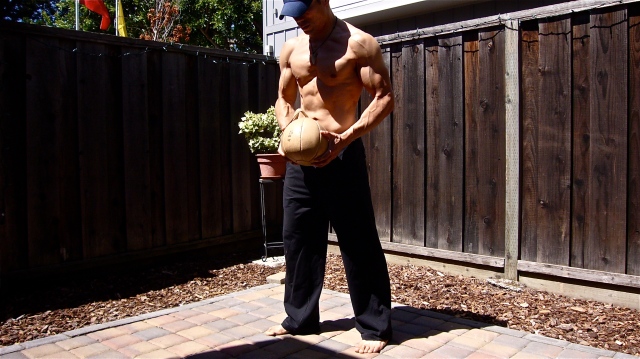Read time: 3 minutes
Yes, this blog is still alive.

From Jonas Peterson's Photos
I’ve been studying the basics of fatherhood, which is probably a good idea since in about a month someone tiny will make her way into the world and call me daddy. I’m trying to give myself the best chance to earn that title.
The worldly things that once mattered — horsepower in cars, friends on facebook, weight lifted, wine on the list, literature and art, price of gas, peace in the Middle East — have all been overshadowed by something still in utero. My concern for all matters expansive or contractive in the entire universe pales in comparison to the hope that my daughter arrives safely into this world and takes her first breath.
Baby Changes Everything
As I face fatherhood, my perspectives are changing. Everything now takes a backseat to the little bundle of the self-insufficient human being that will be my daughter, whose delicate flesh I’ll sacrifice myself to keep safe.
This primal devotion can often trip a typical new father into shell shock and descend him into self-neglect. Perhaps this is why a new father tends to settle for a steady diet of increasing girth and declining health.
Surely it’s good intention, in light of his endless social, professional and financial obligations. Ten, twenty, or 40 pounds of excess body fat is a small price to pay to keep his child warm, safe and fed, and to maintain a roof over her head. A parent will sacrifice much to shield a child from the rain of the literal and the proverbial kind.
I forecast this paternal path for my own fatherhood and I must admit I’m worried about the health and fitness I’ve earned and enjoy (in possibly their final months). Fatherhood means severe sleep deprivation, poor food choices, and utter sloth. It means changing a diaper instead of changing the pin on a weight stack. It means the dreadful creeping of bodyweight and diminishing health.
A Reminder: Simplicity
But as I clicked through the archives of The Lean Saloon, it slowly came to me that everything I’ve written within shall be the ultimate saving grace as I enter the lockdown schedule of fatherhood.
This blog has breathed simplicity into an exercise and diet lifestyle that otherwise has been encumbered with modern information and obsession. The ease of use and the simplicity within The Lean Saloon makes weight loss and weight management realistic and hassle-free.
Less Obsession, More Time for Important Stuff
Less obsession on diet and exercise leaves us with more time and resource to dedicate energy to other pressing matters of life, without sacrificing body, health, and relationship. This leaves me time to be a father while preserving my physique and health.
If you want a lean body with a rational amount of muscle, there’s little need to spend more than 20 or 30 minutes doing formal exercise. That’s a western gimmick.
If you want to stimulate muscle, then create muscle tension through physical activity. In other words, get active, lift something, accelerate something… even if it’s just your body. Or an old medicine ball. Do them with genuine effort.
If you want to have less body fat, then eat less. Do intermittent fasting to make eating less simple. Eat mostly whole, real food; but also enjoy the delicious essence of culture.
Getting lean, staying that way, and becoming healthy cannot get simpler than that.
What I’ve Been Doing and Why There’s No Excuse to Stop
In the past 6 months, my primary exercise equipment has been a trusty 9-pound leather medicine ball. It’s a classic beauty that can be displayed in the living room without looking out of place — it’s a decor item when not in use. But when it’s in use, it takes a beating like… well, an old leather medicine ball.

The Classic Leather Medicine Ball that I've used almost daily. It's like an old buddy. Everyone should have one.
Five days a week for the past 6 months, I simply grab this leather medicine ball and accumulate 100 wood-chops. I do them in segments of 25s, four times through the day, or all at once. I typically do them at high speed. (Force = mass x Acceleration.)
I don’t consider the 100 reps of wood-chops formal exercise; I look at them as purposeful incidental activity. I just do them. This gets me out of the chair to metabolize some fat and sugar. This allows me to let go of the cultural urgency and obsession placed on formal exercise.
As for formal exercise: I perform some bodyweight exercises periodically, and lift a barbell infrequently. Sometimes I go for weeks without formal exercise. It’s because I know that leanness is more about staying active through the day and not overeating.
Focus On the Meaningful Stuff
Don’t complicate and obsess in areas that can be kept simple. There are other things deserving of greater work from us. Counting carbs and counting reps aren’t them. Keep this part simple. Enjoy that part of life that won’t be around forever.

My awesome lovely wife, Lori, 8 months and counting.

With our 5-year-old boxer, as energetic as she was at 5 months. Yes, she does intermittent fasting quite naturally and intuitively.

And, of course, it wouldn't be Johnny at The Lean Saloon without the impromptu shirts-off shot. (It's nice to just whip the shirt off and look decent without having to obsess with diet and exercise and all that ridiculous preparation.)

















